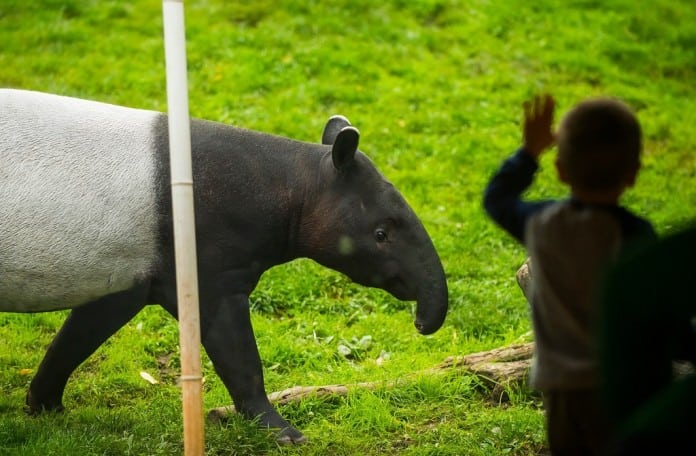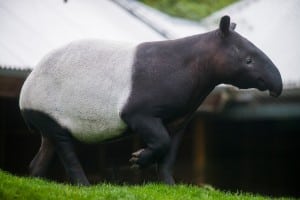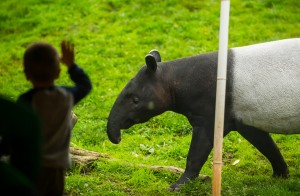
Submitted by Point Defiance Zoo and Aquarium

Amid the green, leafy surroundings of the Asian Forest Sanctuary, the black and white markings of the Malayan tapir stand out as he explores his new home, extending his trunk-like nose to grasp a snack.
But the squeals of Baku, Point Defiance Zoo and Aquarium’s newest resident, ensure he’s not just seen but also heard: The 18-month-old tapir whistles to keepers when he’s hungry or just plain curious.
Now the community will get a chance to meet Baku, who makes his public debut on Saturday, October 10.
Visitors can expect to see Baku in one of the Asian Forest Sanctuary exhibit spaces beginning at 10:00 a.m. Saturday and Sunday, weather permitting.
“Baku is a young, vibrant animal, and we’re very excited to have him here at Point Defiance Zoo,” said staff biologist Christy Webster. “We’re looking forward to helping our visitors learn more about these unusual animals.”
He is the only one of his species at the zoo.
Tapirs are endangered due to hunting and habitat loss, generally from deforestation wrought by palm oil plantations. They are native to Southern Burma, the Malay Peninsula, Southeast Thailand and Sumatra. It is estimated that fewer than 2,000 remain in the wild. There are only 36 in zoos accredited by the Association of Zoos and Aquariums.
Tapirs have unique physical features: A flexible proboscis, or nose, that helps them reach their food, whether leaves and branches above them, or fruit on the ground. Their body configuration and long snout make tapirs look a bit like pigs, but they are actually related to horses and rhinoceroses. Their markings—black in front and back, white and gray in the middle—help camouflage them in the moonlight, when they’re most active.
Tapirs are agile at climbing slopes, and can gallop quickly when scared.

At about 530 pounds and 2 ½ feet tall, Baku is not yet full-grown; adult male tapirs average 3 to 3 ½ feet tall and 800 pounds. He displays a curious personality, Webster said.
“He’s interested in what’s going around him,” she explained. “That makes him a really fun animal to work with. He always wants to know what we’re going to do next.”
Baku isn’t a picky eater, either: He enjoys apples, carrots, yams, romaine lettuce, hay and the grain that’s part of many zoo animals’ diet.
Tapir talk often surprises people, Webster added. The animals can make high-pitched whistling or squealing noises, ranging in pitch or duration. Baku, for example, alerts keepers when he’s impatient, excited, and just eager for attention.
Eventually, a female tapir may join Baku to help grow the population through the Species Survival Plan managed breeding program, Webster said.
For now, the focus will be on getting Baku acclimated to his new environment from his old home at the Denver Zoo. Baku may, for instance, become part of a multi-species exhibit, where he could interact with other Southeast Asian animals, such as white-cheeked gibbons and siamangs.
For more information, visit www.pdza.org.












































